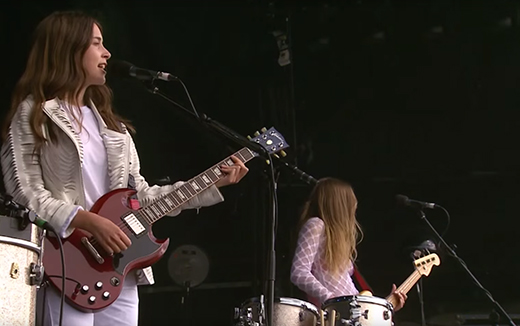The objective of Vampire Weekend’s third record, Modern Vampires of the City was simple: “fresh and new, or die!”
For this reason, the group reached out for the first time for an external co-producer, to assist (now former member) guitarist/keyboardist/songwriter extraordinaire Rostam Batmanglij; this outside intelligence was record producer Ariel Rechtshaid, whose considerable rapsheet includes the likes of Usher, Madonna, and Adele.
Together Batmanglij and Rechtshaid took Modern Vampires of the City on a rigorous voyage of experimentation, with the aim to make a record that sounded like nothing fans had heard before.
For Modern Vampires of the City, Vampire Weekend set out to create something that pushed far beyond anything they’d attempted before. Here’s how it was crafted.
Batmanglij and Rechtshaid: A Duo With Their Fingers on the Pulse
Production sessions were more sophisticated than they’d ever been, thanks to both Batmanglij and Rechtshaid investing in new Macbook Pros with solid state drives, which allowed for hi-def multi-track sessions with unlimited virtual instruments, making desktop all but obsolete. The two also had the ingenious idea to mirror their hard drives with the same software and plug-ins – allowing for long-distance collaboration from both Rechtshaid’s LA studio and Batmanglij’s Brooklyn apartment.
After becoming a proud sponsor for the Avid HD Thunderbolt interface, mastering whiz Emily Lazar – also credited with Vampire Weekend’s debut, as well as their sophomore album Contra – hooked Batmanglij and Rechtshaid up with the Thunderbolt tech, allowing for easy linkage with the rig at her mastering facility, The Lodge. The upshot was that, for the first time, Batmanglij could master and mix simultaneously with sessions straight from laptop.
Universal Audio was also a big player, with Batmanglij and Rechtshaid significantly relying on the UA Apollo, as well as the UAD-2 Satellite FireWire and UAD-2 QUAD PCle DSP cards. On top of this were a host of UAD Powered Plug-Ins. “I’ve pretty much bought everything UAD has built,” Rechstaid told Mix Online.
As for the Apollo, the setup went like so: Rechtshaid’s laptop was plugged into a Thunderbolt monitor display, which ran through an Apollo Thunderbolt port, with another Thunderbolt port plugged into a bus-powered LaCie hard drive. Additional mixing also took place at Downtown Studios in New York, with the use of an API console via a Thunderbolt and Avid DigiLink cable.
The Writing Process: a Slow Cook
Unlike with previous albums, where much of the content was ready to perform prior to recording, Modern Vampires was the result of a year’s worth of experimental simultaneous songwriting and recording. In lieu of jamming as a whole band (which, sadly, proved unfruitful), Batmanglij met with vocalist Ezra Koenig several times a week at the former’s home studio in Brooklyn.
The two also enjoyed a four-day artistic retreat at a Massachusetts island, Martha’s Vineyard, where they set up Batmanglij’s equipment at a friend’s guest cottage and busted out some of the highlights of the album. These included Everlasting Arms, much of Hudson, and Don’t Lie (the acoustic guitar in the latter was recorded on Batmanglij’s desktop at the time and made its way to the final product).
Vampire Weekend’s rhythm section – bassist Chris Baio and drummer Chris Tomson – only really emerged in the later parts of the songwriting process, bringing to life Batmanglij’s programmed ideas and making them “something that was more Vampire Weekend.”
The Modern and The Vintage
Recording sessions were mostly split between four locations: the famed vintage Vox Studios in LA – for strings and rhythm; Batmanglij’s Brooklyn apartment – where his Steinway piano was recorded; and Rechtshaid’s two LA studios – Slow Death in Burbank, and the Echo Park “Back House.”
The latter was a granny flat at Rechstaid’s residence, located beneath an avocado tree and with speakers set up inside by interns from their management companies. This is where vocals for Hannah Hunt were recorded, in rustic fashion. According to Batmanglij, “you can hear the rustling trees if you listen carefully.”
On the recording process, Batmanglij expounded: “It’s been an aspect of the band to use recordings that are made in different places and have different fidelity and to bring all those together… I’ve always thought that was a more interesting aesthetic than something that sounds like everything was recorded with the exact same microphone in the exact same room.”
In honour of this aesthetic, the band also did the most to “cover every era of recording” to create some sort of “caricature” of something being recorded to tape. First, the group made the most of Vox’s analog Ampex 351 one-inch 8-track and MM1200 16-track tape machines to record the album’s drums and bass. These recordings were then digitally edited out the wazoo with Pro Tools and Ableton Live and plug-ins galore. Thanks to the beauty of tape, the drums especially could escape harshness upon compression, allowing Batmanglij to “really mangle them”.
All drums – and all instruments, period – were run through an Ampex mic pre from the ‘60s. “90 percent of the time it wound sound great and we didn’t touch it afterwards for most of what we were tracking,” revealed engineer Dave Shiffman. “Those mic pres were enormous sounding, punchy, and clear; a ‘less is more’ thing.”
As for guitars, Batmanglij capitalised on the UA Apollo for direct recording (vocals were given a similar treatment, with Soundelux U99 mics often plugged straight into the Apollo.) A plethora of plug-ins helped to shape the final sound, most significantly the ATR-102 Mastering Tape Recorder. The ATR, with its “wows” and “flutters,” proved instrumental to creating the vintage sounds that Batmanglij heard in his head. Case in point is the woozy guitar outro of Don’t Lie, both written and played by Batmanglij on his 1980 Les Paul.
All About the Mix
Arguably even more essential than recording was Batmanglij and Rechtshaid’s extensive editing of song arrangements afterwards. According to Rechtshaid, a vital step of the process was “assessing whether that something was familiar… in which case throw it away and start over.”
Rhythm and vocals for Modern Vampires of the City were subject to the most experimentalism in mixing. Take the treatment of drums in Finger Back. After all drum parts had been recorded separately, the kick track was run through a SPL Transient Designer with maximum decay, which emphasised the natural hiss of the tape. Since the live drums had a finite echo, the decay also therefore had a limit; ergo, the decay at max instead grabbed onto the hiss and elevated it, achieving what Batmanglij summed up as “a very modern, sort of French house effect” – via old-school techniques.
The treatments given to the kick also had a much broader and misleading ‘big bass’ effect. As Batmanglij explained, “When people talk about ‘big bass’ what they really mean is that the track is reacting to the kick drum. So much of bass is perceptual.”
Another example is the use of Varispeed on drums on Step – after recording of each part, scratch tracks were bounced to stereo tracks that Tomson could play along with. The live drumming was then slowed back down for a muffled, ethereal quality. Varispeed also was wielded on the Ampex for the recording of congas in Everlasting Arms, causing the tape speed to fluctuate during tracking.
Vocals arguably underwent the most rigour in editing, in the form of vigorous pitch-shifting, namely in Step, Diane Young, and Ya Hey. Originally recorded in G major, the instrumental of Step was pitch-shifted to Bb, with the vocals recorded a semitone down and then pitched up with the rest, purely because “it sounded more interesting and weird.”
The Formant tool in Ableton Live and Antares Autotune were vital for vox editing, allowing Koenig’s timbre to be manipulated at every pitch. Also used to great effect were the Eventime 910 and H949 harmonizers on the pitch-shifted vocals of Ya Hey.
Above all, in mixing and mastering, Batmanglij was concerned with warmth of sound, calling for the use of a Sonnox Oxford SuprEsser plug-in for monitoring and controlling harsh frequencies. Additionally, the entire band were tasked with listening to the record with a range of headphones – from Apple to Sony – to rule out any possibility of painful listening. “I don’t mind erring on the side of warmth, but people are scared shitless to do that,” Batmanglij has ranted at length. “Have you listened to the new records coming out? There’s insane brightness happening. We worked our asses off to not let any single moment sound harsh. You have to be able to enjoy the recording with the volume cranked or it’s not a good mix.”



